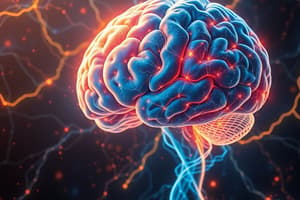Podcast
Questions and Answers
What is synaptogenesis?
What is synaptogenesis?
- The formation of synapses between neurons (correct)
- The insulation of nerve fibers
- The reduction of brain connections
- The process of neuron death
What happens during myelogenesis?
What happens during myelogenesis?
- Myelin is formed around nerve fibers (correct)
- Connections between neurons are increased
- Neurons are pruned
- Synapses are eliminated
How does the number of neurons change from childhood to adolescence?
How does the number of neurons change from childhood to adolescence?
- It fluctuates dramatically each year
- It increases steadily throughout childhood
- It remains constant until adulthood
- It reaches a peak early and then declines (correct)
What is the primary goal of neuropsychology?
What is the primary goal of neuropsychology?
Which of the following is NOT a focus of cognitive neurosciences?
Which of the following is NOT a focus of cognitive neurosciences?
What is the difference between experimental and clinical neuropsychology?
What is the difference between experimental and clinical neuropsychology?
What characterizes research methods in neuropsychology?
What characterizes research methods in neuropsychology?
Which of the following fields does neuropsychology overlap with?
Which of the following fields does neuropsychology overlap with?
What is the primary function of neurons in the nervous system?
What is the primary function of neurons in the nervous system?
Which type of glia cell is responsible for forming the myelin sheath?
Which type of glia cell is responsible for forming the myelin sheath?
Which of the following correctly describes the Central Nervous System (CNS)?
Which of the following correctly describes the Central Nervous System (CNS)?
What is the role of afferent neurons in the nervous system?
What is the role of afferent neurons in the nervous system?
Which structure serves as the site for decussation in the nervous system?
Which structure serves as the site for decussation in the nervous system?
The appearance of neurons with myelin sheaths is commonly referred to as what?
The appearance of neurons with myelin sheaths is commonly referred to as what?
What is the primary function of cerebrospinal fluid (CSF)?
What is the primary function of cerebrospinal fluid (CSF)?
Which glial cell type is involved in removing dead or damaged tissue within the nervous system?
Which glial cell type is involved in removing dead or damaged tissue within the nervous system?
What does cognitive rehabilitation primarily rely on?
What does cognitive rehabilitation primarily rely on?
What is neural sprouting?
What is neural sprouting?
Which of the following best describes long-term potentiation (LTP)?
Which of the following best describes long-term potentiation (LTP)?
What role does neurogenesis play in structural neuroplasticity?
What role does neurogenesis play in structural neuroplasticity?
How do compensatory techniques function in cognitive rehabilitation?
How do compensatory techniques function in cognitive rehabilitation?
What is the primary goal of physiotherapy as described?
What is the primary goal of physiotherapy as described?
Which of the following is considered a resource of positive plasticity?
Which of the following is considered a resource of positive plasticity?
What best describes negative plasticity?
What best describes negative plasticity?
Which cognitive function is closely related to the dorsal pathway?
Which cognitive function is closely related to the dorsal pathway?
What is a defining characteristic of optic ataxia?
What is a defining characteristic of optic ataxia?
Which symptom is NOT associated with Balint-Holmes Syndrome?
Which symptom is NOT associated with Balint-Holmes Syndrome?
What do patients with simultanagnosia struggle with?
What do patients with simultanagnosia struggle with?
Which of the following is a symptom of Gerstmann’s Syndrome?
Which of the following is a symptom of Gerstmann’s Syndrome?
What distinguishes the dorsal from the ventral form of simultanagnosia?
What distinguishes the dorsal from the ventral form of simultanagnosia?
Which of the following best describes anosognosia in Balint-Holmes Syndrome?
Which of the following best describes anosognosia in Balint-Holmes Syndrome?
Gerstmann’s Syndrome can be characterized by which of the following deficits?
Gerstmann’s Syndrome can be characterized by which of the following deficits?
What is the primary characteristic of Broca's aphasia?
What is the primary characteristic of Broca's aphasia?
Which type of words are typically omitted in Broca's aphasia?
Which type of words are typically omitted in Broca's aphasia?
What does the term 'telegraphic speech' refer to in relation to Broca's aphasia?
What does the term 'telegraphic speech' refer to in relation to Broca's aphasia?
Which of the following is NOT a symptom of Broca's aphasia?
Which of the following is NOT a symptom of Broca's aphasia?
Which statement is true about patients with Broca's aphasia?
Which statement is true about patients with Broca's aphasia?
Which of the following conditions most commonly leads to aphasia?
Which of the following conditions most commonly leads to aphasia?
What is a significant aspect of Broca's aphasia regarding language function?
What is a significant aspect of Broca's aphasia regarding language function?
What is NOT a characteristic of brain lesions that cause aphasia?
What is NOT a characteristic of brain lesions that cause aphasia?
What is the role of the phonological input lexicon?
What is the role of the phonological input lexicon?
What is meant by 'anomia' in lexicon organization?
What is meant by 'anomia' in lexicon organization?
Which of the following factors contributes to a word's resistance to errors?
Which of the following factors contributes to a word's resistance to errors?
What type of error is described by using a word without any relation of meaning, such as saying 'tablecloth' for 'telephone'?
What type of error is described by using a word without any relation of meaning, such as saying 'tablecloth' for 'telephone'?
How does word frequency affect the cognitive organization of lexicon?
How does word frequency affect the cognitive organization of lexicon?
Which type of lexical error involves replacing a target word with one from the same category, such as saying 'car' for 'van'?
Which type of lexical error involves replacing a target word with one from the same category, such as saying 'car' for 'van'?
What characterizes anomic latency?
What characterizes anomic latency?
What happens to connection strengths of words during early learning?
What happens to connection strengths of words during early learning?
Flashcards
Neurons
Neurons
Specialized cells responsible for transmitting electrical impulses throughout the nervous system.
Glia Cells
Glia Cells
Cells that support and protect neurons, providing structure and aiding in communication.
Myelin Sheath
Myelin Sheath
A fatty substance that wraps around axons, increasing the speed of nerve impulse transmission.
Central Nervous System (CNS)
Central Nervous System (CNS)
Signup and view all the flashcards
Peripheral Nervous System (PNS)
Peripheral Nervous System (PNS)
Signup and view all the flashcards
Skeletal Nervous System
Skeletal Nervous System
Signup and view all the flashcards
Autonomic Nervous System
Autonomic Nervous System
Signup and view all the flashcards
Afferent/Sensory Neurons
Afferent/Sensory Neurons
Signup and view all the flashcards
Brain Plasticity
Brain Plasticity
Signup and view all the flashcards
Neurogenesis
Neurogenesis
Signup and view all the flashcards
Sprouting
Sprouting
Signup and view all the flashcards
Rerouting
Rerouting
Signup and view all the flashcards
Long-Term Potentiation (LTP)
Long-Term Potentiation (LTP)
Signup and view all the flashcards
Long-Term Depression (LTD)
Long-Term Depression (LTD)
Signup and view all the flashcards
Cognitive Remediation
Cognitive Remediation
Signup and view all the flashcards
Compensatory Techniques
Compensatory Techniques
Signup and view all the flashcards
Synaptogenesis
Synaptogenesis
Signup and view all the flashcards
Neural Pruning
Neural Pruning
Signup and view all the flashcards
Myelination
Myelination
Signup and view all the flashcards
Neuropsychology
Neuropsychology
Signup and view all the flashcards
Cognitive Neurosciences
Cognitive Neurosciences
Signup and view all the flashcards
Clinical Neuropsychology
Clinical Neuropsychology
Signup and view all the flashcards
Experimental Neuropsychology
Experimental Neuropsychology
Signup and view all the flashcards
The Study of Single Cases
The Study of Single Cases
Signup and view all the flashcards
Anomia
Anomia
Signup and view all the flashcards
Semantic Paraphasia
Semantic Paraphasia
Signup and view all the flashcards
Verbal Paraphasia
Verbal Paraphasia
Signup and view all the flashcards
Categorial Paraphasia
Categorial Paraphasia
Signup and view all the flashcards
Associative Paraphasia
Associative Paraphasia
Signup and view all the flashcards
Superordinate Paraphasia
Superordinate Paraphasia
Signup and view all the flashcards
Subordinate Paraphasia
Subordinate Paraphasia
Signup and view all the flashcards
Phonological Output Lexicon
Phonological Output Lexicon
Signup and view all the flashcards
Affordances
Affordances
Signup and view all the flashcards
Optic Ataxia
Optic Ataxia
Signup and view all the flashcards
Balint-Holmes Syndrome
Balint-Holmes Syndrome
Signup and view all the flashcards
Simultanagnosia
Simultanagnosia
Signup and view all the flashcards
Gerstmann's Syndrome
Gerstmann's Syndrome
Signup and view all the flashcards
Finger Agnosia
Finger Agnosia
Signup and view all the flashcards
Loss of Navon effect
Loss of Navon effect
Signup and view all the flashcards
Piecemeal Visual Scanning
Piecemeal Visual Scanning
Signup and view all the flashcards
Aphasia
Aphasia
Signup and view all the flashcards
Syndrome
Syndrome
Signup and view all the flashcards
Aphasic Syndrome
Aphasic Syndrome
Signup and view all the flashcards
Aetiology
Aetiology
Signup and view all the flashcards
Broca's Aphasia
Broca's Aphasia
Signup and view all the flashcards
Agrammatism
Agrammatism
Signup and view all the flashcards
Telegraphic Speech
Telegraphic Speech
Signup and view all the flashcards
Speech Programming Deficit
Speech Programming Deficit
Signup and view all the flashcards
Study Notes
Neurons and Glia
- Neurons transmit electrical impulses throughout the nervous system; they communicate with other neurons or muscles via synaptic transmission.
- A human brain contains 100-150 billion neurons.
- Glia cells support neurons; oligodendrocytes produce myelin sheaths, increasing nerve impulse propagation speed.
- Microglia remove dead tissue, and astrocytes regulate the transfer of nutrients & harmful substances between blood and brain.
Nervous Systems
- Central Nervous System (CNS): composed of brain and spinal cord,
- Peripheral Nervous System (PNS): composed of everything else, including
- Skeletal nervous system: carries nerve impulses to voluntary muscles.
- Autonomic nervous system: carries nerve impulses to involuntary muscles.
- Afferent (sensory) neurons: carry impulses toward the brain.
- Efferent (motor) neurons: carry impulses away from the brain.
- White Matter: myelinated neurons (pink-white).
- Grey Matter: unmyelinated neurons (gray).
The Brain
- The brain coordinates all bodily functions and consists of four regions: cerebrum, cerebellum, brainstem, and diencephalon.
- Somatosensation (Afferent neurons): sensory information from the body to the somatosensory cortex.
- Motor control (Efferent neurons): motor output from the motor cortex, to innervate muscles.
Cerebrospinal Fluid (CSF)
- Clear, colorless fluid that circulates around the CNS, allowing nutrient and chemical diffusion.
- It protects the brain and spinal cord.
Blood Supply
- Cerebral arteries supply oxygenated blood.
- Cerebral veins drain deoxygenated blood.
- The blood-brain barrier protects brain tissue from harmful blood elements while allowing passage of substances necessary for metabolic functions.
Studying That Suits You
Use AI to generate personalized quizzes and flashcards to suit your learning preferences.




